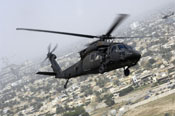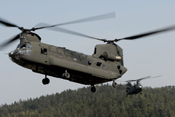Vietnam: The Helicopter War
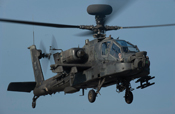
120127-N-PB383-090 ARABIAN GULF (Jan. 27, 2011) A U.S. Army AH-64 Apache helicopter approaches the flight deck of the amphibious transport dock ship USS New Orleans (LPD 18) during deck landing qualifications. New Orleans and embarked Marines assigned to the 11th Marine Expeditionary Unit (11th MEU) are deployed as part of the Makin Island Amphibious Ready Group, supporting maritime security operations and theater security cooperation efforts in the U.S. 5th Fleet area of responsibility. (U.S. Navy photo by Mass Communication Specialist 2nd Class Dominique Pineiro/Released
www.navy.mil
The Helicopter After Vietnam
The immense success of the helicopter in the Vietnam War set an important precedent in the years following the conflict. The numerous benefits the helicopter provided to the American military proved to militaries around the world that rotary-wing technology would continue to shape warfare, both in combat and support activities. Helicopter technology has continued to evolve over the decades, producing some of the most advanced aerial weapons platforms in existence.
AH-64 Apache Longbow
The AH-64 Apache Longbow entered service in the U.S. Army in 1984. This heavy attack helicopter is armed with Hellfire missiles, 2.75" rockets, and a 30mm chain gun. It also boasts some of the world's most advanced fire control radar technology, avionics, and navigation systems.
UH-60 Black Hawk
The UH-60 Black Hawk is a utility transport helicopter that replaced the UH-1 Iroquois. Entering service in 1979, the Black Hawk featured marked improvements over the UH-1 in capacity and lift capabilities, can move through the battle zone at a much higher airspeed, and is designed to promote a higher level of crew safety. As with its predecessor, the Black Hawk's versatility allows it to perform troop transport, medical evacuation, and a variety of combat support activities.
CH-47 Chinook
The venerable CH-47 Chinook still serves the U.S. military in much the same way that it has since it was introduced in 1962. Major upgrades to the Chinook have improved its performance in every aspect, and this invaluable craft remains the reliable transporter of troops and supplies wherever U.S. forces are deployed. Equipped with more powerful engines than the earlier Chinooks, the modern version is also equipped with a fully-digital cockpit, and its cargo area can hold over thirty troops or two HMMWVs (Humvee vehicles).
OH-58D Kiowa Warrior
The successor to the earlier models of the OH-58, the D model Kiowa Warrior serves as an armed reconnaissance helicopter. Much safer and faster than the earlier models, the OH-58D is equipped with two quick-change weapons pylons that can employ two Stinger missiles, a .50-caliber machine gun, 2.75" rockets, or two Hellfire missiles, depending on the requirements of each mission.
V-22 Osprey
The Bell-Boeing V-22 Osprey is the world's first tilt-rotor aircraft. The Osprey is designed to combine the tactical versatility of a helicopter with the speed, range, cargo capacity, and high-altitude flight of a turbo-prop airplane. The Osprey is capable of vertical takeoff and landing, and when airborne can tilt its wing-mounted rotors forward and operate in flight as an airplane. It can be employed in a variety of mission types, including troop insertion and extraction, medical evacuation, search-and-rescue missions, amphibious assault, and in a combat support role.
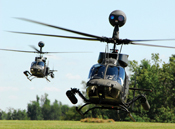
The 5th Battalion, 101st Aviation Regiment, 101st Combat Aviation Brigade set up a forward area rearming and refueling point at a local farm in Troy, Tenn. Sept. 30 during Operation Diomedes, an Air Assault exercise offering Soldiers from the 5-101 and 2nd Battalion, 327th Infantry Regiment, 1st Brigade Combat Team the opportunity to train in unfamiliar terrain. PHOTOS BY SADIE E. BLEISTEIN
www.army.mil
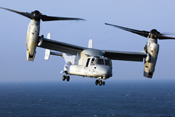
080708-N-4014G-085 ATLANTIC OCEAN (July 8, 2008) A V-22 Osprey aircraft from the "Thunder Chickens" of Marine Medium Tiltrotor Squadron (VMM) 263 takes off from the multi-purpose amphibious assault ship USS Bataan (LHD 5). Bataan is conducting routine operations in the Atlantic Ocean. U.S. Navy photo by Mass Communication Specialist 3rd Class Patrick Gearhiser (Released)
www.navy.mil
Bibliography
- Allen, Matthew. Military Helicopter Doctrines of the Major Powers, 1945-1992. Westport, CT: Greenwood Press, 1993.
- Boyne, Walter J. How the Helicopter Changed Modern Warfare. Gretna, LA: Pelican Publishing Company, Inc., 2011.
- "Military Helicopters," http://www.guncopter.com
- "Military Helicopters," http://www.militaryfactory.com/aircraft/military-helicopters.asp
- Omholt, Ralph. "The Helicopter's Grim Future in Modern Combat," Military.com. 3 December 2003. http://www.military.com/NewContent/0,13190,Defensewatch_120303_Helicopter,00.html
- Ripley, Tim. Jane’s Pocket Guide: Modern Military Helicopters. NY: HarperCollins Publishers, 1998.
- AH-64 Apache Longbow - www.navy.mil
- OH-60 Blackhawk - www.army.mil
- CH-47 Chinook - www.army.mil
- OH-58D Kiowa Warrior - www.army.mil
- V-22 Osprey - www.navy.mil
Exhibit Credits:
- Kelly Crager
- Katrina Jackson
- Steve Maxner
- Amy Mondt
- Sheon Montgomery
- Mary Saffell
- Justin Saffell
- Special Thanks To: Robyn Galloway and Gloria Lerma
Vietnam Center & Sam Johnson Vietnam Archive
-
Address
Texas Tech University, Box 41041, Lubbock, TX 79409 -
Phone
(806)742-9010 -
Email
vnca@ttu.edu


